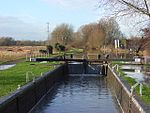Reading Green Park railway station

Reading Green Park railway station is a railway station under construction in Reading, Berkshire, England. The station is intended to serve the Green Park business area and the Madejski Stadium, as well as the proposed Green Park Village residential development. It will be on the Reading to Basingstoke Line, south of Southcote Junction. The station, which has planning permission from Reading Borough Council and funding in place from the Government, was set to open in late 2020 but its completion was delayed by the coronavirus pandemic. Although it was subsequently planned to open the station during the summer of 2022, it is currently scheduled to open in early 2023.The station will be served by stopping services operated by Great Western Railway between Reading and Basingstoke, with an expected frequency of two trains per hour in each direction. The station will have two 5-car long canopied platforms, which will be connected by a 15-metre (49 ft) bridge, with lifts and stairs at each end. The station will have an interchange with the existing Green Park Park and Ride bus system, together with a taxi rank, surface level car park and cycle parking.
Excerpt from the Wikipedia article Reading Green Park railway station (License: CC BY-SA 3.0, Authors, Images).Reading Green Park railway station
Kirton's Farm Road,
Geographical coordinates (GPS) Address External links Nearby Places Show on map
Geographical coordinates (GPS)
| Latitude | Longitude |
|---|---|
| N 51.426733333333 ° | E -1.0013388888889 ° |
Address
Reading Green Park
Kirton's Farm Road
RG2 6DN , Burghfield
England, United Kingdom
Open on Google Maps










